Impact of Ethnic Residential Concentration in Cabramatta Report
VerifiedAdded on 2020/03/16
|7
|1365
|32
Report
AI Summary
This report examines the impact of ethnic residential concentration in Cabramatta, a suburb of Sydney, Australia, often referred to as the 'Vietnamese capital of Australia.' The essay uses photographs and secondary data to analyze the benefits and challenges of this concentration. Benefits highlighted include the promotion of harmonious community relations through events like the Moon Festival, and the resources provided by the Whitlam Library, and the Vietnam War Comradeship Memorial. Challenges discussed include high drug usage, social exclusion, stereotyping, and the potential for cultural integration issues. The report concludes that while ethnic concentration offers cultural benefits, the community must also address challenges to foster social cohesion and commitment to national values. This assignment is available on Desklib, a platform providing AI-driven study tools.

UNIT:
NAME:
DATE:
NAME:
DATE:
Paraphrase This Document
Need a fresh take? Get an instant paraphrase of this document with our AI Paraphraser
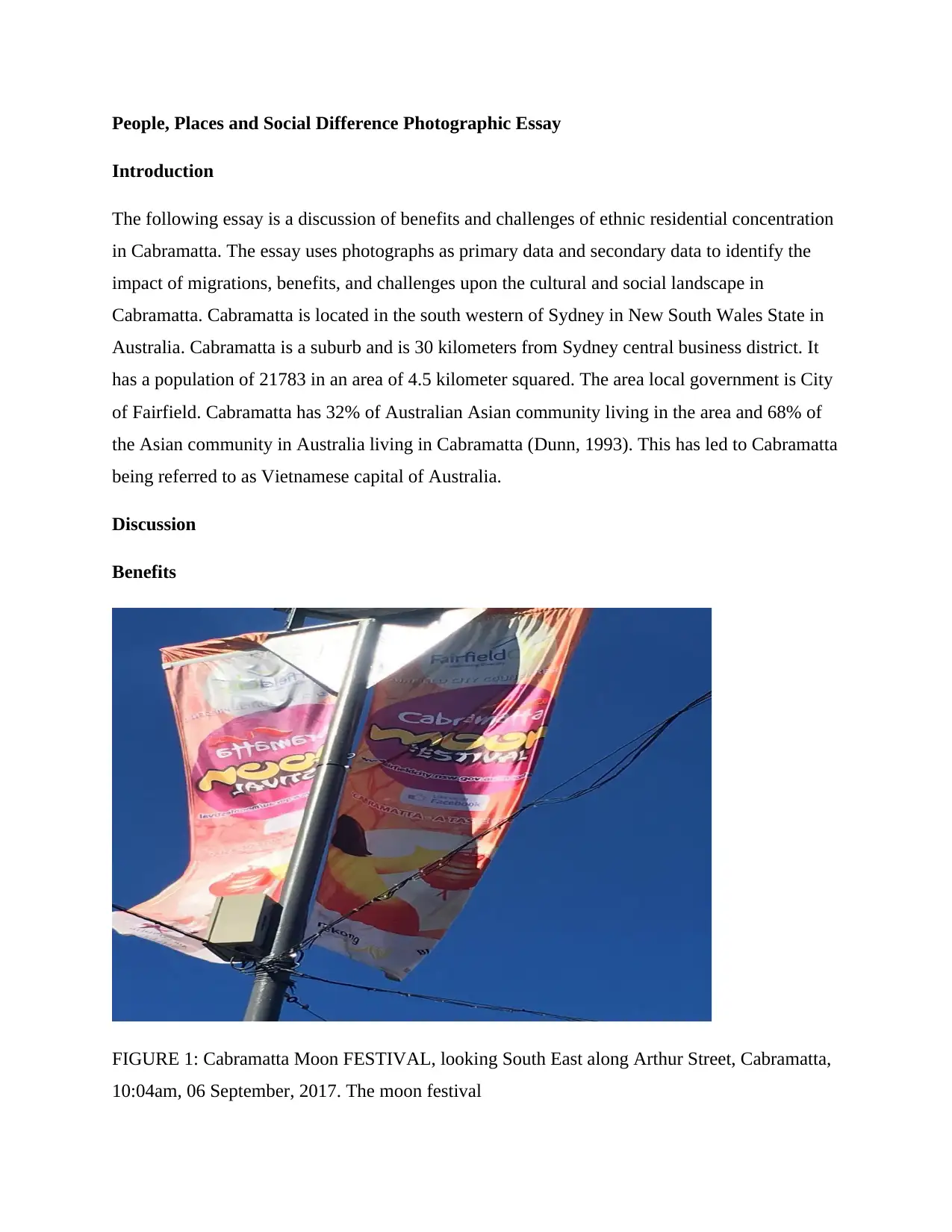
People, Places and Social Difference Photographic Essay
Introduction
The following essay is a discussion of benefits and challenges of ethnic residential concentration
in Cabramatta. The essay uses photographs as primary data and secondary data to identify the
impact of migrations, benefits, and challenges upon the cultural and social landscape in
Cabramatta. Cabramatta is located in the south western of Sydney in New South Wales State in
Australia. Cabramatta is a suburb and is 30 kilometers from Sydney central business district. It
has a population of 21783 in an area of 4.5 kilometer squared. The area local government is City
of Fairfield. Cabramatta has 32% of Australian Asian community living in the area and 68% of
the Asian community in Australia living in Cabramatta (Dunn, 1993). This has led to Cabramatta
being referred to as Vietnamese capital of Australia.
Discussion
Benefits
FIGURE 1: Cabramatta Moon FESTIVAL, looking South East along Arthur Street, Cabramatta,
10:04am, 06 September, 2017. The moon festival
Introduction
The following essay is a discussion of benefits and challenges of ethnic residential concentration
in Cabramatta. The essay uses photographs as primary data and secondary data to identify the
impact of migrations, benefits, and challenges upon the cultural and social landscape in
Cabramatta. Cabramatta is located in the south western of Sydney in New South Wales State in
Australia. Cabramatta is a suburb and is 30 kilometers from Sydney central business district. It
has a population of 21783 in an area of 4.5 kilometer squared. The area local government is City
of Fairfield. Cabramatta has 32% of Australian Asian community living in the area and 68% of
the Asian community in Australia living in Cabramatta (Dunn, 1993). This has led to Cabramatta
being referred to as Vietnamese capital of Australia.
Discussion
Benefits
FIGURE 1: Cabramatta Moon FESTIVAL, looking South East along Arthur Street, Cabramatta,
10:04am, 06 September, 2017. The moon festival
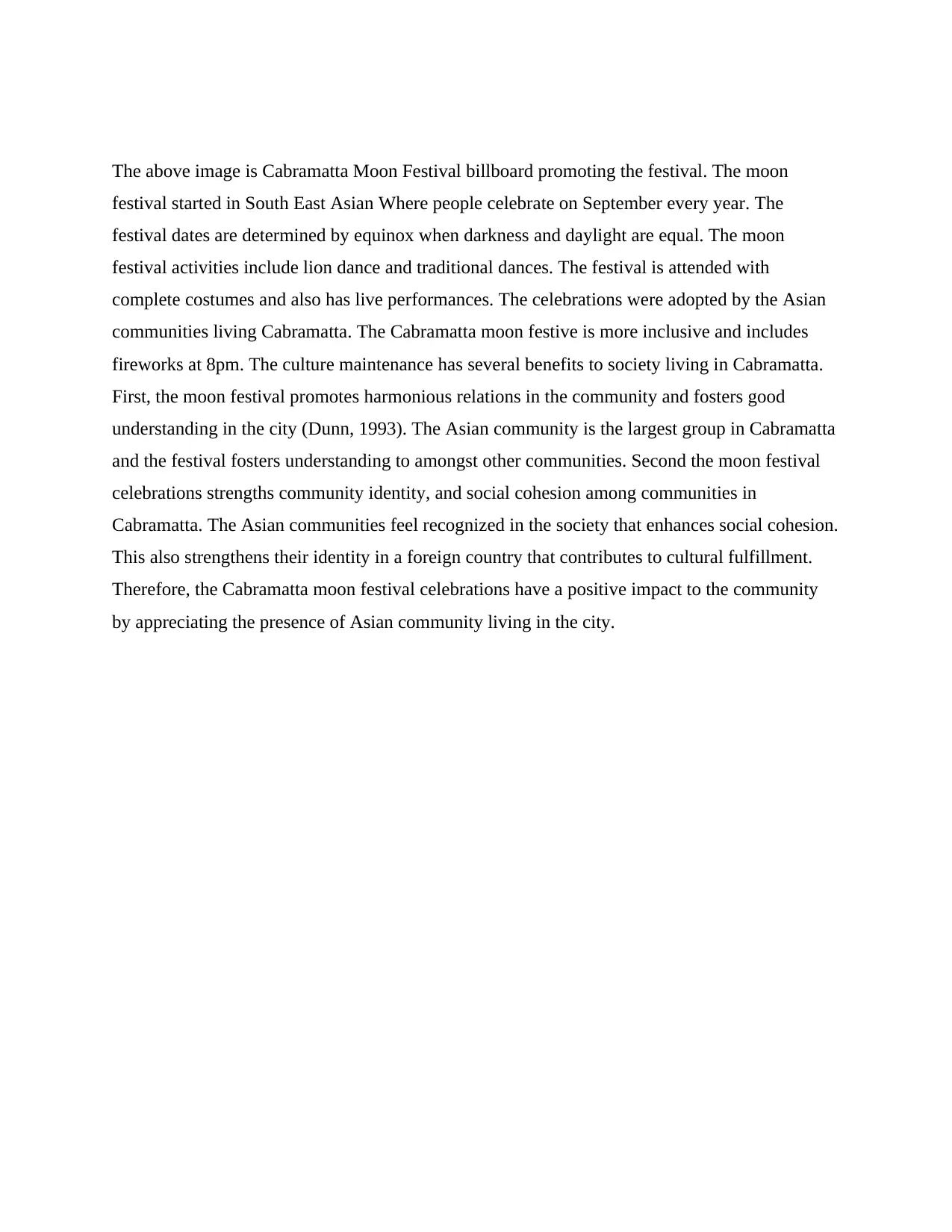
The above image is Cabramatta Moon Festival billboard promoting the festival. The moon
festival started in South East Asian Where people celebrate on September every year. The
festival dates are determined by equinox when darkness and daylight are equal. The moon
festival activities include lion dance and traditional dances. The festival is attended with
complete costumes and also has live performances. The celebrations were adopted by the Asian
communities living Cabramatta. The Cabramatta moon festive is more inclusive and includes
fireworks at 8pm. The culture maintenance has several benefits to society living in Cabramatta.
First, the moon festival promotes harmonious relations in the community and fosters good
understanding in the city (Dunn, 1993). The Asian community is the largest group in Cabramatta
and the festival fosters understanding to amongst other communities. Second the moon festival
celebrations strengths community identity, and social cohesion among communities in
Cabramatta. The Asian communities feel recognized in the society that enhances social cohesion.
This also strengthens their identity in a foreign country that contributes to cultural fulfillment.
Therefore, the Cabramatta moon festival celebrations have a positive impact to the community
by appreciating the presence of Asian community living in the city.
festival started in South East Asian Where people celebrate on September every year. The
festival dates are determined by equinox when darkness and daylight are equal. The moon
festival activities include lion dance and traditional dances. The festival is attended with
complete costumes and also has live performances. The celebrations were adopted by the Asian
communities living Cabramatta. The Cabramatta moon festive is more inclusive and includes
fireworks at 8pm. The culture maintenance has several benefits to society living in Cabramatta.
First, the moon festival promotes harmonious relations in the community and fosters good
understanding in the city (Dunn, 1993). The Asian community is the largest group in Cabramatta
and the festival fosters understanding to amongst other communities. Second the moon festival
celebrations strengths community identity, and social cohesion among communities in
Cabramatta. The Asian communities feel recognized in the society that enhances social cohesion.
This also strengthens their identity in a foreign country that contributes to cultural fulfillment.
Therefore, the Cabramatta moon festival celebrations have a positive impact to the community
by appreciating the presence of Asian community living in the city.
⊘ This is a preview!⊘
Do you want full access?
Subscribe today to unlock all pages.

Trusted by 1+ million students worldwide
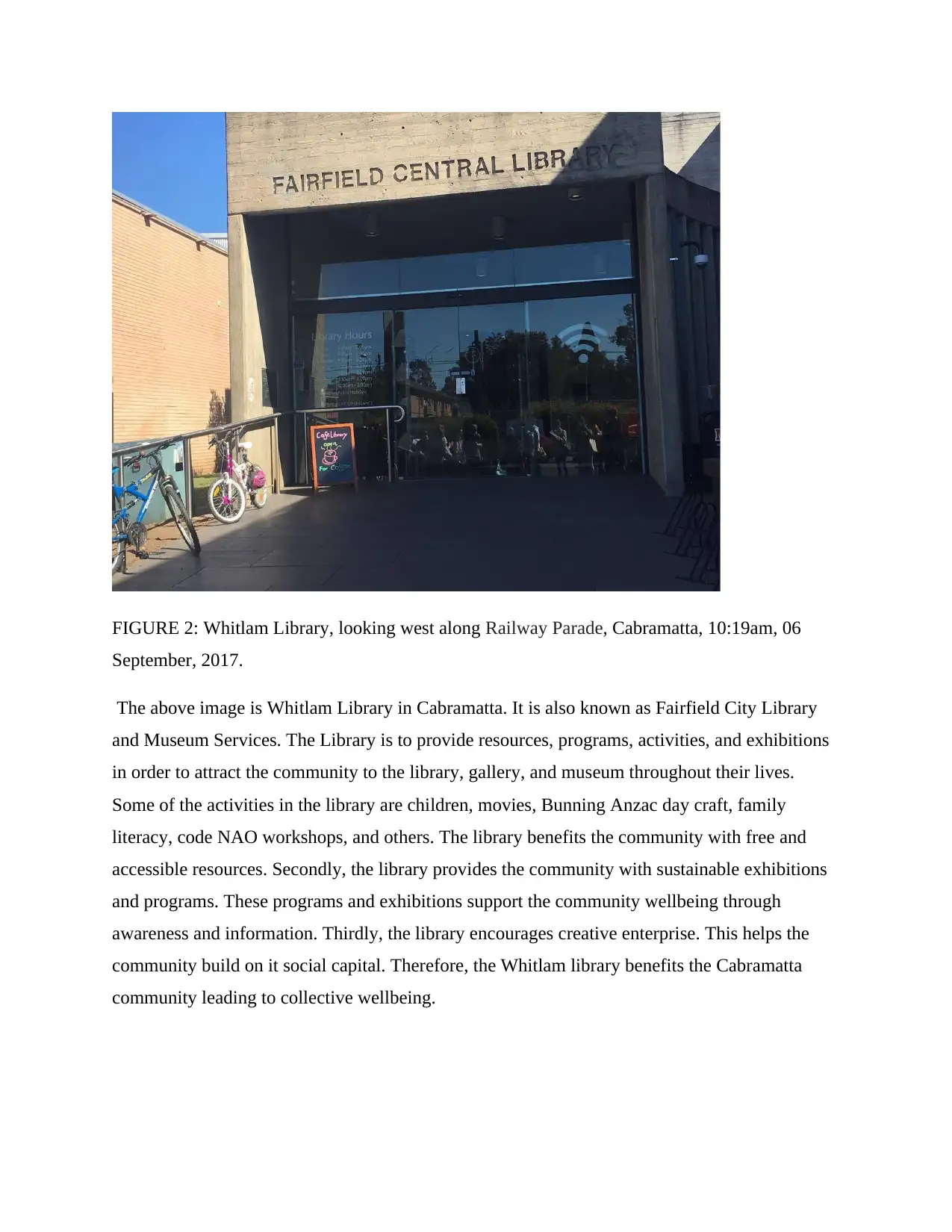
FIGURE 2: Whitlam Library, looking west along Railway Parade, Cabramatta, 10:19am, 06
September, 2017.
The above image is Whitlam Library in Cabramatta. It is also known as Fairfield City Library
and Museum Services. The Library is to provide resources, programs, activities, and exhibitions
in order to attract the community to the library, gallery, and museum throughout their lives.
Some of the activities in the library are children, movies, Bunning Anzac day craft, family
literacy, code NAO workshops, and others. The library benefits the community with free and
accessible resources. Secondly, the library provides the community with sustainable exhibitions
and programs. These programs and exhibitions support the community wellbeing through
awareness and information. Thirdly, the library encourages creative enterprise. This helps the
community build on it social capital. Therefore, the Whitlam library benefits the Cabramatta
community leading to collective wellbeing.
September, 2017.
The above image is Whitlam Library in Cabramatta. It is also known as Fairfield City Library
and Museum Services. The Library is to provide resources, programs, activities, and exhibitions
in order to attract the community to the library, gallery, and museum throughout their lives.
Some of the activities in the library are children, movies, Bunning Anzac day craft, family
literacy, code NAO workshops, and others. The library benefits the community with free and
accessible resources. Secondly, the library provides the community with sustainable exhibitions
and programs. These programs and exhibitions support the community wellbeing through
awareness and information. Thirdly, the library encourages creative enterprise. This helps the
community build on it social capital. Therefore, the Whitlam library benefits the Cabramatta
community leading to collective wellbeing.
Paraphrase This Document
Need a fresh take? Get an instant paraphrase of this document with our AI Paraphraser
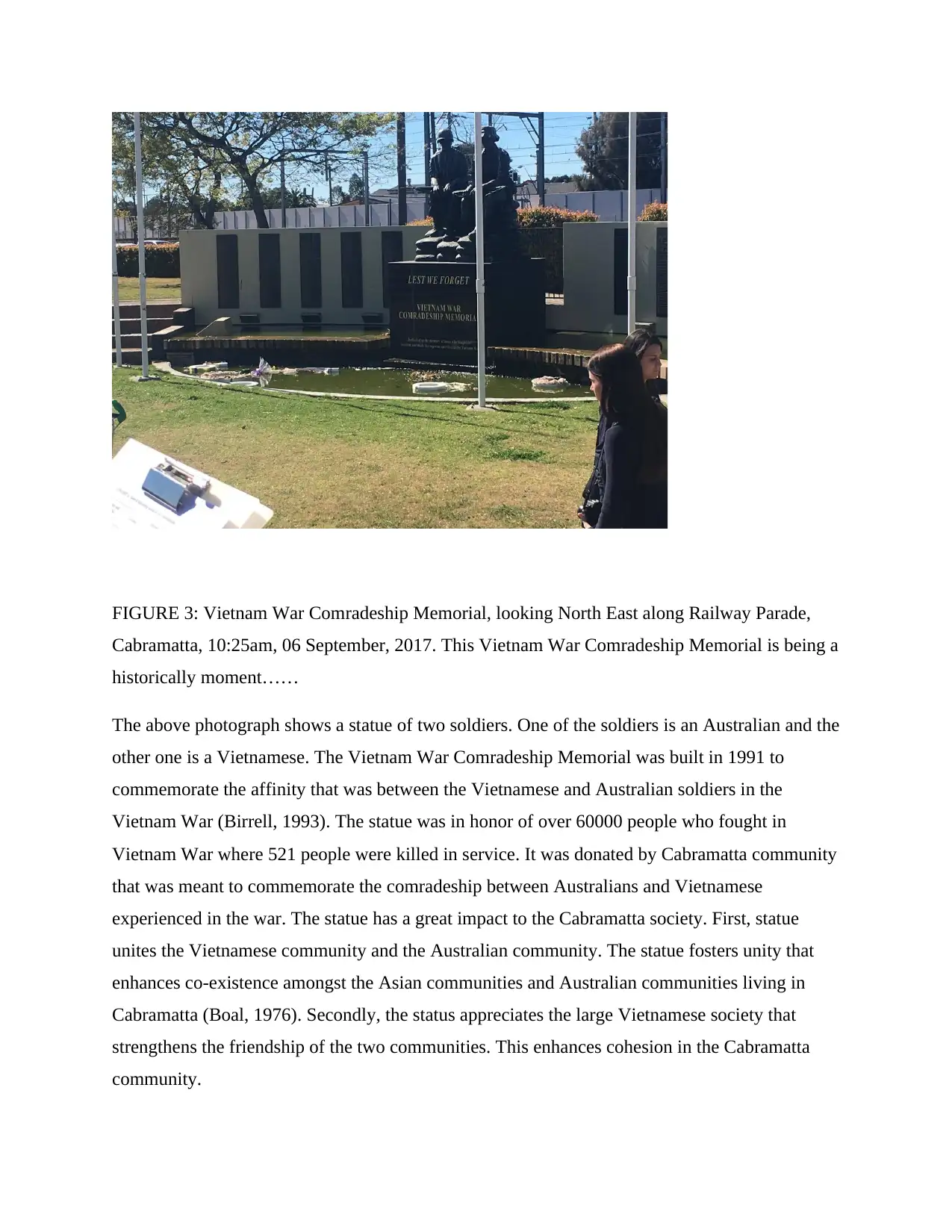
FIGURE 3: Vietnam War Comradeship Memorial, looking North East along Railway Parade,
Cabramatta, 10:25am, 06 September, 2017. This Vietnam War Comradeship Memorial is being a
historically moment……
The above photograph shows a statue of two soldiers. One of the soldiers is an Australian and the
other one is a Vietnamese. The Vietnam War Comradeship Memorial was built in 1991 to
commemorate the affinity that was between the Vietnamese and Australian soldiers in the
Vietnam War (Birrell, 1993). The statue was in honor of over 60000 people who fought in
Vietnam War where 521 people were killed in service. It was donated by Cabramatta community
that was meant to commemorate the comradeship between Australians and Vietnamese
experienced in the war. The statue has a great impact to the Cabramatta society. First, statue
unites the Vietnamese community and the Australian community. The statue fosters unity that
enhances co-existence amongst the Asian communities and Australian communities living in
Cabramatta (Boal, 1976). Secondly, the status appreciates the large Vietnamese society that
strengthens the friendship of the two communities. This enhances cohesion in the Cabramatta
community.
Cabramatta, 10:25am, 06 September, 2017. This Vietnam War Comradeship Memorial is being a
historically moment……
The above photograph shows a statue of two soldiers. One of the soldiers is an Australian and the
other one is a Vietnamese. The Vietnam War Comradeship Memorial was built in 1991 to
commemorate the affinity that was between the Vietnamese and Australian soldiers in the
Vietnam War (Birrell, 1993). The statue was in honor of over 60000 people who fought in
Vietnam War where 521 people were killed in service. It was donated by Cabramatta community
that was meant to commemorate the comradeship between Australians and Vietnamese
experienced in the war. The statue has a great impact to the Cabramatta society. First, statue
unites the Vietnamese community and the Australian community. The statue fosters unity that
enhances co-existence amongst the Asian communities and Australian communities living in
Cabramatta (Boal, 1976). Secondly, the status appreciates the large Vietnamese society that
strengthens the friendship of the two communities. This enhances cohesion in the Cabramatta
community.
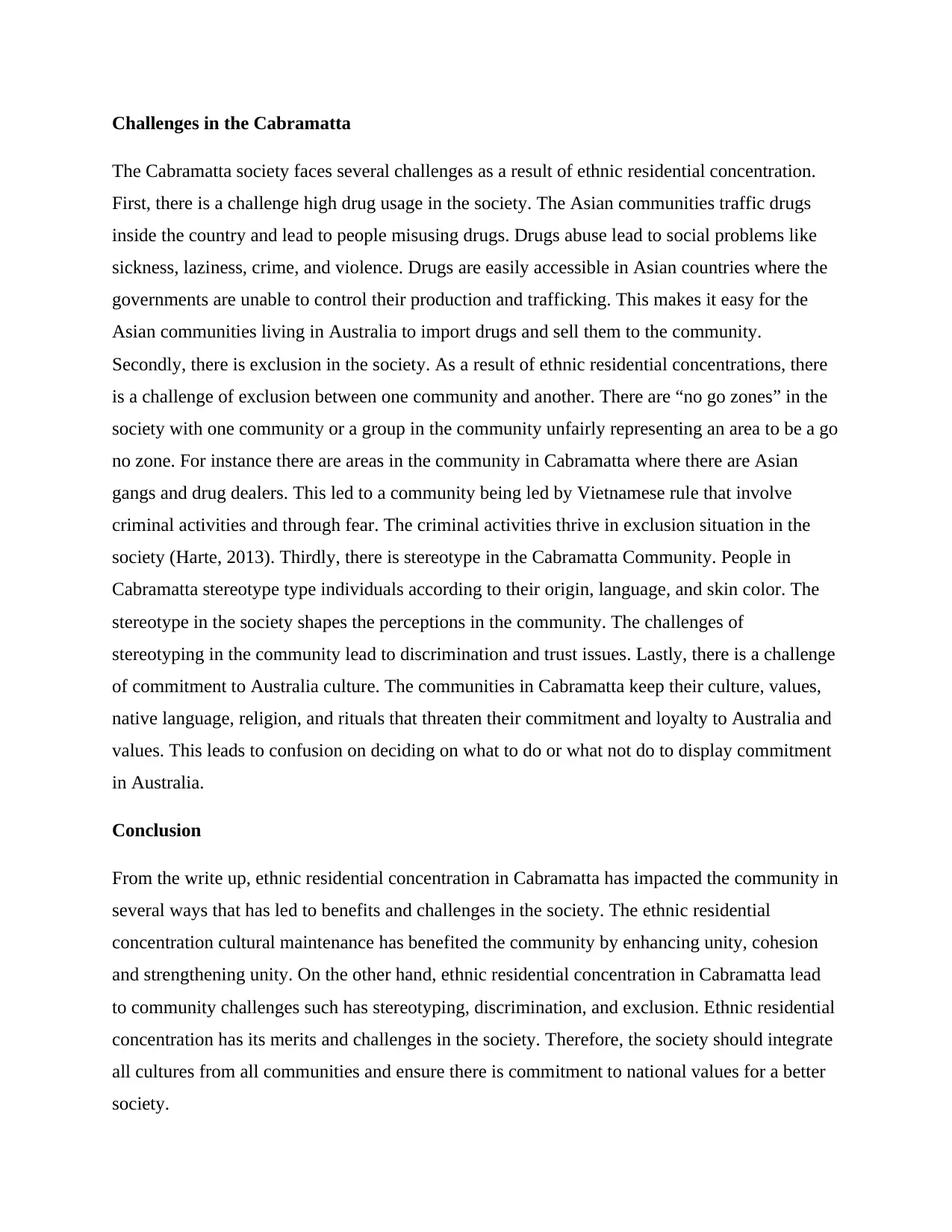
Challenges in the Cabramatta
The Cabramatta society faces several challenges as a result of ethnic residential concentration.
First, there is a challenge high drug usage in the society. The Asian communities traffic drugs
inside the country and lead to people misusing drugs. Drugs abuse lead to social problems like
sickness, laziness, crime, and violence. Drugs are easily accessible in Asian countries where the
governments are unable to control their production and trafficking. This makes it easy for the
Asian communities living in Australia to import drugs and sell them to the community.
Secondly, there is exclusion in the society. As a result of ethnic residential concentrations, there
is a challenge of exclusion between one community and another. There are “no go zones” in the
society with one community or a group in the community unfairly representing an area to be a go
no zone. For instance there are areas in the community in Cabramatta where there are Asian
gangs and drug dealers. This led to a community being led by Vietnamese rule that involve
criminal activities and through fear. The criminal activities thrive in exclusion situation in the
society (Harte, 2013). Thirdly, there is stereotype in the Cabramatta Community. People in
Cabramatta stereotype type individuals according to their origin, language, and skin color. The
stereotype in the society shapes the perceptions in the community. The challenges of
stereotyping in the community lead to discrimination and trust issues. Lastly, there is a challenge
of commitment to Australia culture. The communities in Cabramatta keep their culture, values,
native language, religion, and rituals that threaten their commitment and loyalty to Australia and
values. This leads to confusion on deciding on what to do or what not do to display commitment
in Australia.
Conclusion
From the write up, ethnic residential concentration in Cabramatta has impacted the community in
several ways that has led to benefits and challenges in the society. The ethnic residential
concentration cultural maintenance has benefited the community by enhancing unity, cohesion
and strengthening unity. On the other hand, ethnic residential concentration in Cabramatta lead
to community challenges such has stereotyping, discrimination, and exclusion. Ethnic residential
concentration has its merits and challenges in the society. Therefore, the society should integrate
all cultures from all communities and ensure there is commitment to national values for a better
society.
The Cabramatta society faces several challenges as a result of ethnic residential concentration.
First, there is a challenge high drug usage in the society. The Asian communities traffic drugs
inside the country and lead to people misusing drugs. Drugs abuse lead to social problems like
sickness, laziness, crime, and violence. Drugs are easily accessible in Asian countries where the
governments are unable to control their production and trafficking. This makes it easy for the
Asian communities living in Australia to import drugs and sell them to the community.
Secondly, there is exclusion in the society. As a result of ethnic residential concentrations, there
is a challenge of exclusion between one community and another. There are “no go zones” in the
society with one community or a group in the community unfairly representing an area to be a go
no zone. For instance there are areas in the community in Cabramatta where there are Asian
gangs and drug dealers. This led to a community being led by Vietnamese rule that involve
criminal activities and through fear. The criminal activities thrive in exclusion situation in the
society (Harte, 2013). Thirdly, there is stereotype in the Cabramatta Community. People in
Cabramatta stereotype type individuals according to their origin, language, and skin color. The
stereotype in the society shapes the perceptions in the community. The challenges of
stereotyping in the community lead to discrimination and trust issues. Lastly, there is a challenge
of commitment to Australia culture. The communities in Cabramatta keep their culture, values,
native language, religion, and rituals that threaten their commitment and loyalty to Australia and
values. This leads to confusion on deciding on what to do or what not do to display commitment
in Australia.
Conclusion
From the write up, ethnic residential concentration in Cabramatta has impacted the community in
several ways that has led to benefits and challenges in the society. The ethnic residential
concentration cultural maintenance has benefited the community by enhancing unity, cohesion
and strengthening unity. On the other hand, ethnic residential concentration in Cabramatta lead
to community challenges such has stereotyping, discrimination, and exclusion. Ethnic residential
concentration has its merits and challenges in the society. Therefore, the society should integrate
all cultures from all communities and ensure there is commitment to national values for a better
society.
⊘ This is a preview!⊘
Do you want full access?
Subscribe today to unlock all pages.

Trusted by 1+ million students worldwide
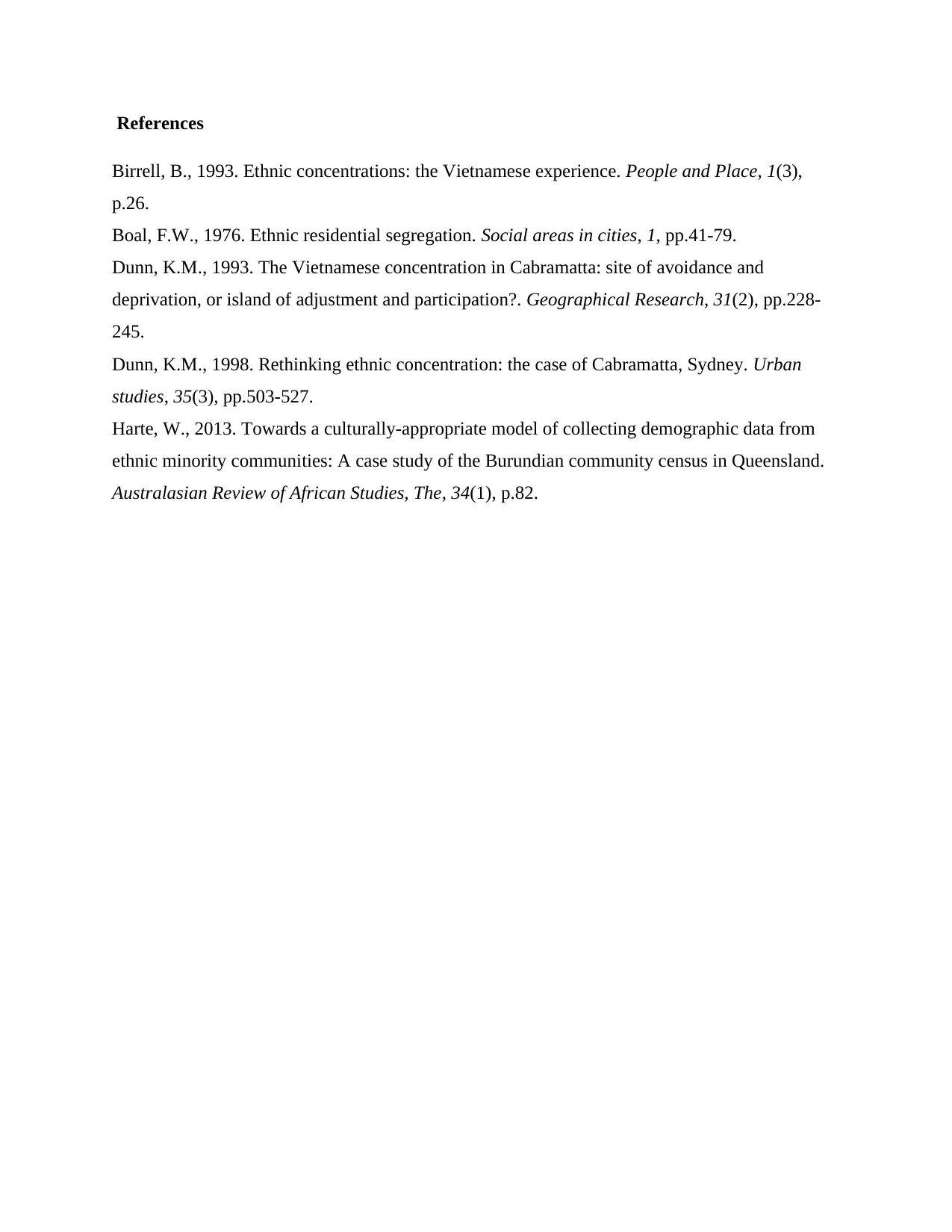
References
Birrell, B., 1993. Ethnic concentrations: the Vietnamese experience. People and Place, 1(3),
p.26.
Boal, F.W., 1976. Ethnic residential segregation. Social areas in cities, 1, pp.41-79.
Dunn, K.M., 1993. The Vietnamese concentration in Cabramatta: site of avoidance and
deprivation, or island of adjustment and participation?. Geographical Research, 31(2), pp.228-
245.
Dunn, K.M., 1998. Rethinking ethnic concentration: the case of Cabramatta, Sydney. Urban
studies, 35(3), pp.503-527.
Harte, W., 2013. Towards a culturally-appropriate model of collecting demographic data from
ethnic minority communities: A case study of the Burundian community census in Queensland.
Australasian Review of African Studies, The, 34(1), p.82.
Birrell, B., 1993. Ethnic concentrations: the Vietnamese experience. People and Place, 1(3),
p.26.
Boal, F.W., 1976. Ethnic residential segregation. Social areas in cities, 1, pp.41-79.
Dunn, K.M., 1993. The Vietnamese concentration in Cabramatta: site of avoidance and
deprivation, or island of adjustment and participation?. Geographical Research, 31(2), pp.228-
245.
Dunn, K.M., 1998. Rethinking ethnic concentration: the case of Cabramatta, Sydney. Urban
studies, 35(3), pp.503-527.
Harte, W., 2013. Towards a culturally-appropriate model of collecting demographic data from
ethnic minority communities: A case study of the Burundian community census in Queensland.
Australasian Review of African Studies, The, 34(1), p.82.
1 out of 7
Your All-in-One AI-Powered Toolkit for Academic Success.
+13062052269
info@desklib.com
Available 24*7 on WhatsApp / Email
![[object Object]](/_next/static/media/star-bottom.7253800d.svg)
Unlock your academic potential
Copyright © 2020–2025 A2Z Services. All Rights Reserved. Developed and managed by ZUCOL.
